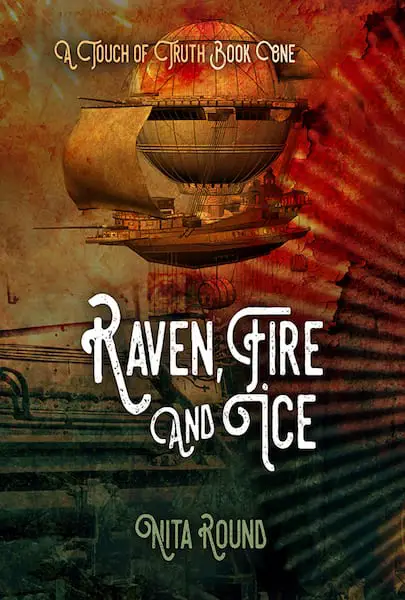Steampunk seems to be making a comeback in fantasy literature—or maybe it never left and I just haven’t been paying attention. Regardless, I’ve been seeing more and more queer steampunk fantasy in particular, which has got to be exciting for queer fans who love the genre and have always wanted to see themselves represented. The latest to cross my desk is Nita Round’s Raven, Fire and Ice, the first in her Touch of Truth Series. If you’re looking for a trio of fleshed out queer protagonists to root for and aren’t afraid of blood, this is one to check out.
A Brief (Spoiler Free) Run-Down
 Lucinda Ravensburgh sees the truth in everything she touches. When Captain Magda Stoner of the airship Verity, asks for her help in a very strange and messy crime, Lucinda cannot refuse. From that moment on, Lucinda’s life is changed forever. She discovers, no matter what the obstacle, nor the troubles they encounter, finding the truth is paramount.
Lucinda Ravensburgh sees the truth in everything she touches. When Captain Magda Stoner of the airship Verity, asks for her help in a very strange and messy crime, Lucinda cannot refuse. From that moment on, Lucinda’s life is changed forever. She discovers, no matter what the obstacle, nor the troubles they encounter, finding the truth is paramount.
The Good Stuff
As difficult as good queer representation is to come by, finding queer poly representation in fiction can be next to impossible. That Inevitable Victorian Thing blew me away with its ending (I have yet to read The Fifth Season but it is on my reading list). So, needless to say, when I find books that have queer poly dynamics, I’m thrilled beyond measure.
In this regard, Raven, Fire and Ice did not disappoint. Thus far in the series, Lucinda, Magda, and Ascara are still exploring their dynamic, but I adore the subtext and tension between the three of them. They’re unique, well-rounded, and well-fleshed out female characters. One fleshed out queer female protagonist is a blessing, but three? That’s a feast!
Imagine, if you would, the best final evolution of Sansa Stark possible (from the A Song of Ice and Fire books of course, not the show). Then give her Brienne of Tarth and Asha Greyjoy (also from the books) as her right- and left-hand women. Then make them all queer and potential lovers in a poly threesome and you have Lucinda, Magda, and Ascara. Lucinda’s charisma, empathy, self-confidence, and skill serve her well as the primary protagonist. Magda’s stoic calmness and sense of justice make her an ideal second, and Ascara’s sly comments and more impulsive behavior act as an excellent balance to Magda’s more measured approach. When you put all three of these ladies together, you can see just why they work so well as a team, both in terms of their quest and romantically. In short, I love these ladies and can’t wait to see more of their adventures together.
The mystery surrounding the blood is well done, and I loved the investigative plot thread. Round clearly knows how to write crime, even crime of a more magical nature. Fantasy setting plus a murder plot? Yes please. It’s two of my favorite genres put together, and now that I’ve seen it, I want more stories with these elements together.
Nita Round uses Lucinda’s magical ‘truth seeing’ to good effect in developing that plot thread, which is a joy to read because the idea behind psychometry, as she calls it, is fascinating. While on paper not that much different than, say, the way ‘seeing’ someone’s memories worked iZombie, Raven, Fire and Ice didn’t feel the same at all reading it. Round took an idea that’s been done before in other media and made it her own in a really compelling way. That’s the mark of a good writer: someone who can make an ‘old’ idea feel new again.
Potential Drawbacks
While Round’s scripting of the criminal and investigative scenes worked beautifully, I found some of the magic-focused scenes confusing. The scene toward the middle of the book where Lucinda interacts with a new tower in particular left me a bit vague on what exactly had happened. Granted, certain action elements and implications of this scene seemed to have been left intentionally mysterious—perhaps to be fleshed out in one of the sequels?—so I’m not sure if my confusion was intentional on the author’s part or not. However, there’s a fine line between ‘air of mystery because magic’ and ‘I have no idea what just happened.’ For me, certain moments fell too far into the latter, but your mileage may vary.
The book also has a few pacing issues, mostly due to the magic-oriented scenes. The final confrontation, a magical one, felt rushed, especially after all the buildup in the preceding pages. I’m also a bit confused on the action beats. They could have been fleshed out a bit more, which would have drawn out the encounter in a more satisfying way.
Then there’s the previously mentioned scene with Lucinda and the Raven tower. On the one hand, the specific scene with Lucinda and the tower is absolutely necessary for the plot to progress the way it does. At the same time, it also feels like an aside, especially in hindsight. It puts the main murder mystery plot on hold for several chapters, and I think pacing suffers as a result. Once again, this might be a mileage may vary issue. If you’re as much invested in the magic as the murder, it probably won’t bother you. Since I was more heavily invested in solving the crime, such a long detour didn’t work as well for me.
This scene in particular also raises the issue of the racial dynamics in the book. Before you rush ahead, I will say there’s nothing horribly racist about the book. However, there are some dynamics that, while I’m absolutely certain are unintentional, still aren’t that great. The malevolent power behind the crimes committed in the book, Sh’Na, comes from Africa, specifically Egypt. The first follower of Sh’Na that we meet is a black boy, and the other adherent is also racially coded as non-white. With few other primary characters of color, this didn’t sit well with me.
Neither did Lucinda, a white woman from the Angles (the book’s analogue to England), coming to Ame’Rica (yep, that’s the US) and gaining control of a magical tower while all the tribes coded as Indigenous Peoples stood around and cheered. It had an undertone of the colonialist white savior to it that, again, is likely unintentional but still uncomfortable to read.
To my mind, deeper worldbuilding could have balanced these two unfortunate dynamics. We know that this world is a future remnant of some kind of global disaster plus magic. But, we have little knowledge of how that disaster shaped geopolitics or racial/ethnic identities. Did societies fall back on a kind of isolationist tribalism that could explain how separate the Victorian-style cities are from the Indigenous-coded populations? Are the Angles analogous to colonial England or something less squicky?
What we do have worldbuilding wise paints a tantalizing picture of a new, different world, but it isn’t enough to not fill in the blanks from history in a way that leads to unfortunate implications for racial dynamics. An explicit primary protagonist of color, or two, would have gone a long way as well to balance these dynamics as well. Having the Indigenous-coded populations be more racially diverse could have also worked well to minimize the sense that Lucinda is a white savior coming into a predominantly non-white culture and ‘taking over’ their magic.
Final Score: 7/10
Raven, Fire and Ice features robust and well-written trio of female protagonists in a unique setting that combines steampunk fantasy with a murder mystery. While certain plot threads worked better than others for me, it is an overall engaging read and I look forward to the sequel. I especially hope that the sequel addresses some of the more unfortunate implications in racial dynamics. Again, none of them felt malicious. It’s mostly about juxtaposition and context, not the content per se. I think that a few tweaks could have done much to minimize them, and I’m more than willing to wait and see how the next book deals with Sh’Na and the Ama’Rican nomads. Rather than dismiss it outright, I recommend reading it for yourself. There’s still plenty to enjoy about it!
About the Author

Nita has been writing all of her life in one form or another and loves telling stories. In fact, her head is so full of stories she is grateful to let them out to play. Once out, more stories jump in to fill the space.
When not writing, she loves being outdoors in the garden, walking the dog on the heathland and forests of Cannock Chase, or visiting site of places of interest and national heritage. Any other free time is spent reading, cooking, and drinking wine. She is an avid gamer, with such classic tabletop games as “Dungeons and Dragons,” and “The Call of Cthulhu,” to name a few. She also likes making flavored alcohol, and her damson gin has been blamed for many a headache. No one has yet learned to say no though.
Nita Round can also be found on Facebook, Twitter, Pinterest, and even has a channel on YouTube. Make sure to visit her website, too!
—
Raven, Fire and Ice is available for purchase on Amazon and Barnes and Noble.
—
Note: The author of this review received a copy of the book in exchange for a free and honest review.

